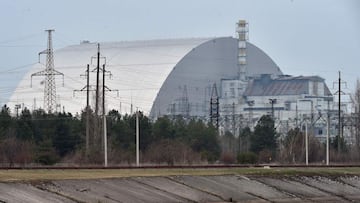Where is Chernobyl? What is the exclusion zone and why is Russia interested?
Russia has taken over the exclusion area surrounding the Chernobyl in the north of Ukraine, situated very close to the border with Belarus.


In 1986, the Ukrainian city of Peipyat, home to the Chernobyl Nuclear Power Plan, was the site of the worst nuclear disaster in human history. The city and surrounding area which was once homes to millions had to be evacuated because the high levels of radiation emanating from the nuclear site.
On 24 February, Russian forces captured the city, raising concerns over what would happen should a bombardment occur in the area. Many are wondering why Russian President Vladimir Putin would be interested in taking control of the area when it has since been abandoned.
However, Russia's interest in the area has less to do with the incident at Chernobyl and more to do with its proximity to the Belarusian border. The site is only around ten miles from the border, making it one of the easiest entry points into Ukraine for Russian troops. However, because of Belarus' proximity its people have been some of the most impacted by the nuclear disaster.
For those who watched "Chernobyl". Belarus suffered the most from the catastrophe, and radiation is still there. Here is the map of radioactive pollution, 2006. pic.twitter.com/kgN4JXsGw1
— Franak Viačorka (@franakviacorka) June 6, 2019
What is the exclusion zone?
After the crisis, the exclusion zone, or the “zone of alienation” was established around Chernobyl to protect people from radiation. Originally, the area includes a 30 kilometer radius around the power plant. Later, the zone was expanded to cover a total of 2,600 km2 (1,000 sq mi).
The zone was divided into three areas: Black, Red, and Blue.
The Black Zone which was the area closest to the site was designated an area where evacuees would never be allowed to return do to the toxic levels of radiation picked up.
The Red Zone experienced high levels of radiation, but it was assumed that overtime the levels would normalize and people would be able to return.
The Blue Zone had lower levels of radiation than the Red Zone, but it was advised that vulnerable populations like pregnant women and children be evacuated.
Follow the latest from Chernobyl here...
- Russia invades Ukraine: live updates
- SWIFT, the banking system Europe could use to sanction Russia over Ukraine
- Anonymous declares war against Russia: starting a cyber war
How many people had to be evacuated?
After the nuclear accident people in and around the area began to fall ill because of the high levels of radiation. Some of the side effects includes headaches, metallic taste in the mouth, and vomiting.
Nuclear Regulation service of Ukraine: available data showing increase of radiation in Chornobyl Exclusion Zone https://t.co/faTnYMJYwO pic.twitter.com/ms6ELg5xdK
— Liveuamap (@Liveuamap) February 25, 2022
Related stories
As the situation worsened, officials declared that a temporary evacuation order would be put in place. Residents were told that they would need to leave for three days and to only bring what was necessary. Many of those evacuated were never able to return, never seeing their personal belongings or homes again.
Directly following the accident, around 135,000 people were evacuated, but by 2000 that number had tripled to over 350,000. While scientists have determined that the area is still unsafe for human health, almost two hundred people have returned as of 2016. Many of those who returned did so illegally but as the majority are senior citizens, the state allowed it and now provides some services to the communities.

